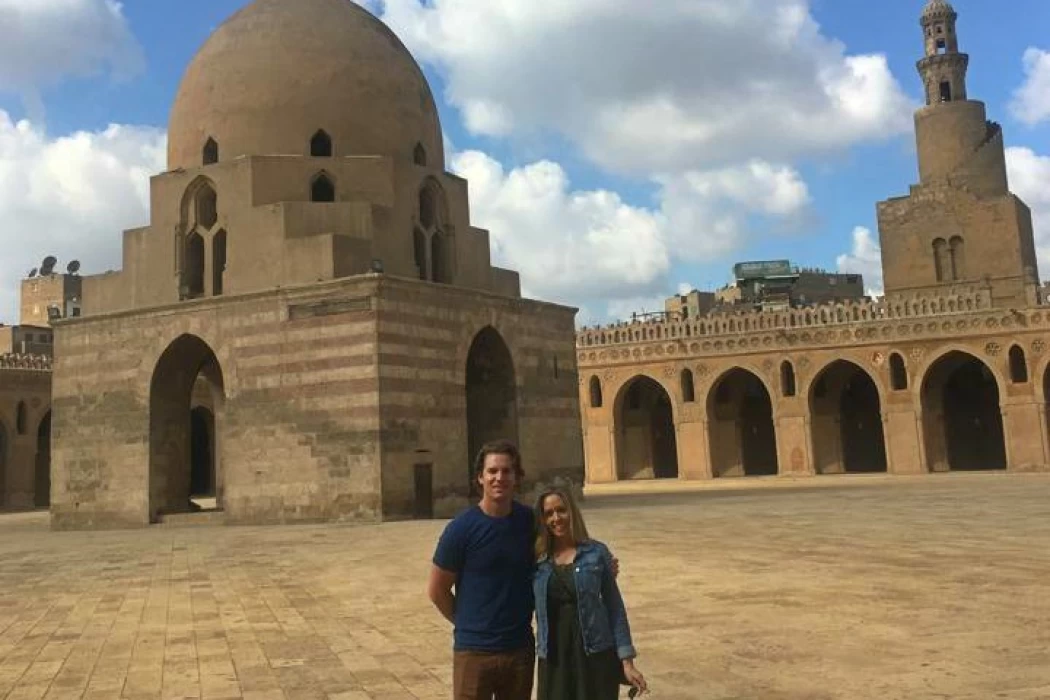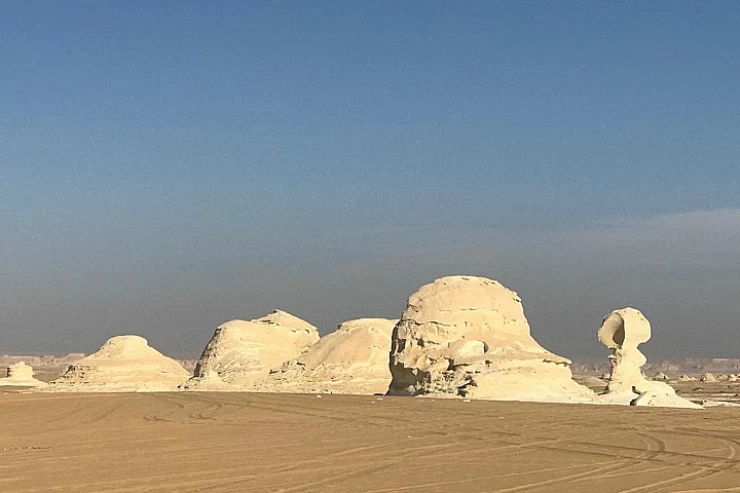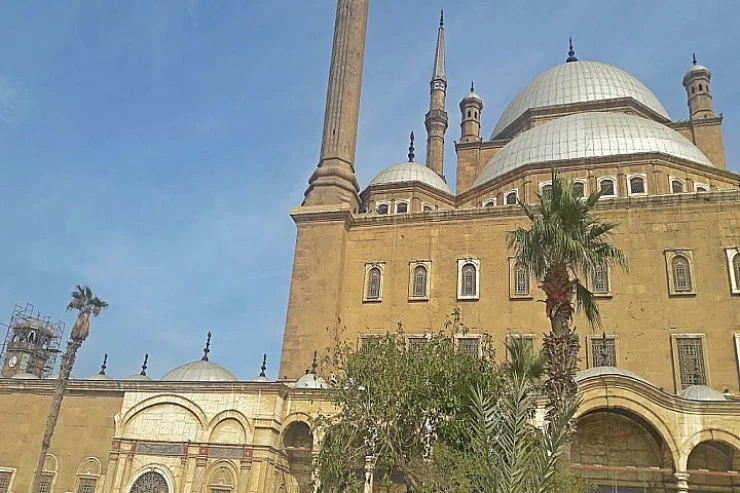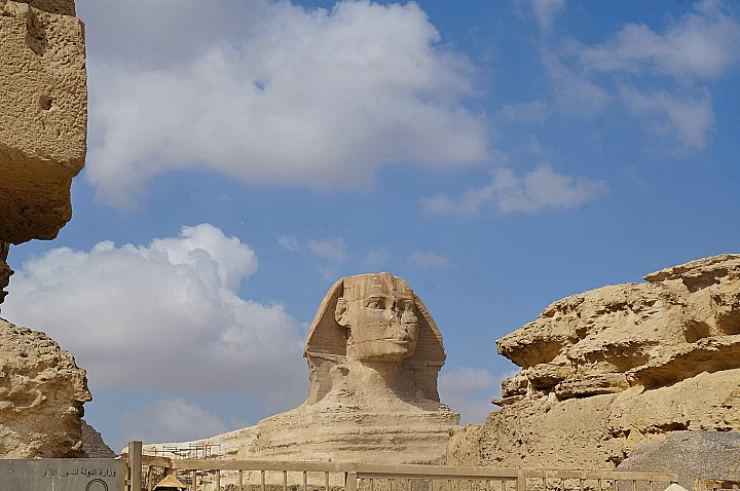
Ahmad Ibn Tulun Mosque
The Ibn Tulun Mosque spans an area of 26,318 square meters and is enclosed by a wall. It ranks as the third-largest mosque globally, yet it is not frequently included in the typical Cairo Day Tours itinerary.
The arches of the Ahmad Ibn Tulun Mosque, which adorn the courtyard, feature intricately carved concrete, marking its first use in Cairo.
The minaret of this mosque is unique in Egypt, resembling the minaret of Samarra, with a distinctive spiral staircase on the exterior. This design reflects Andalusian influences introduced to Egypt.
Visitors can access the minaret of Ahmad Ibn Tulun Mosque via an external passage. From the small chamber at the top, one can enjoy a remarkable view of the mosque below, as well as a sweeping panorama that includes the minarets of the Sultan Hassan Mosque and the stunning Alabaster Mosque of Mohammed Ali within the citadel.
Islamic Cairo
The mosque, along with numerous other architectural marvels of Islamic Cairo, can be explored through one of Egypt's Luxury tours, which offer stays at premier hotels and Nile cruises. Alternatively, for those on a tighter budget, a variety of affordable Egypt tour packages are available. Additionally, for travelers with physical disabilities, our professional operators have curated a selection of wheelchair-accessible tour packages that utilize accessible vehicles and facilities, a key feature of our Egypt classic tours.
Construction of the mosque was initiated by Ahmad Ibn Tulun between 870 and 879 AD to house his collections. It is recognized as the third congregational mosque established in Cairo and is the oldest mosque in Egypt that has largely retained its original structure.
Ibn Tulun, the son of a Turkish laborer of Mongol descent, was owned by the Abbasid Caliph al-Mamun. His heritage contributed significantly to his rise in power, leading to the establishment of the Tulunid Dynasty in Egypt, which lasted from 868 to 905 AD.
Upon assuming control of Egypt, Ibn Tulun founded a new city named al-Qatai'. This location is steeped in biblical history, believed to be the landing site of Noah's Ark, the area where Moses confronted Pharaoh's magicians, and the vicinity where Abraham nearly sacrificed Isaac.
In the 12th century, the site served as a refuge for pilgrims, resulting in some deterioration. The Mosque underwent its first restoration under Mamluk Sultan Lajin in 1296, which included the reconstruction of its renowned minaret. To truly appreciate Egypt and its historical treasures, one must visit the country and explore the enigmas of this ancient region, guided by the experts at Cairo Top Tours.
Additionally, the Mahmoud Khalil Museum in Egypt offers an opportunity to delve into the rich culture and history of Islamic Cairo.
The Mosque of Ibn Tulun is one of the prominent Islamic structures in the city of Cairo and is among the oldest mosques found in the country of Egypt. The mosque, which was built thousands of years ago, has been the destination for space lovers—and bizarre architecture-filled open space, tall ceilings, and the charming spiral-shaped minaret. The mosque was constructed in 879–880 CE by Ahmad Ibn Tulun, the initiator of the Tulunid dynasty, and even after more than a millennium, it remains an example of art in the Islamic tradition and history. Engaging with this fantastic site is like engaging with history. It is a reprieve from the city’s chaos as one gets to appreciate a central aspect of the nation, which is Egypt.
Erased many of them. The order for the construction of the mosque was given by Ahmad Ibn Tulun, a governor of Turkic origin who oversaw Egypt and part of Syria during the Abbasid Caliphate from 868–884. One of the reasons that Ibn Tulun came into power was to establish a government and cultural center that was not controlled by the Abbasids in Baghdad, and so he planned the construction of al-Qata-I city as his stronghold. The pavement of the present resembling this new town was laid in the years 876–879 AD with a church that was designed to symbolize his rule.
Unlike any other mosque found in Cairo, which is often packed with other buildings, Ahmad Ibn Tulun Mosque sits in its large compound. This allows the mosque to achieve a certain majestic serenity akin to the beautiful but barren desert scenery that inspired its design. The construction of the mosque employs local raw materials, brick, and plaster, putting into perspective the distinctive appeal of the mosque.
The intricate details and the many distinctive features of the Ahmad Ibn Tulun Mosque are not something that can be easily overlooked. The mosque’s architectural layout is similar to the traditional design of a hypostyle mosque with a large open courtyard flanked by several rows of arches and a ceilinged region above the area of worship. While the form of the mosque may seem simple, it is, in fact, very sensible and well-suited to the environment. This is because it has indoor spaces that are protected from the harsh sun for some quiet reflection or prayers.
The Courtyard and Ablution Fountain
Among the highlights of the mosque is an enormous open area that serves as a courtyard that is about 92 meters long on all sides and allows a great deal of space for the congregation. At the center is a sail, or an ablution fountain, built during the Mamluk era, making it stand out from the other mosques. The elegant curves and the dome of the fountain are in harmony with the structure of the mosque, providing no resistance to the rationale behind its construction.
The Hypostyle Prayer Hall
A series of large brick bears and horseshoe arches characteristic of this architectural style support the wallpaper. These piers are embellished with complex plasterwork, which is one of the earliest examples of such in this country. As a result of introducing plaster carving, several kinds of intricate designs, like geometry and plants, which also beautify the same stark interior, were possible.
The spiral minaret
Perhaps the most distinct attribute of the Ahmad Ibn Tulun Mosque is its distinctive spiral minaret. Unlike other minarets found in Cairo, this one takes inspiration from the well-known minaret of the Great Mosque of Samarra in Iraq, where Ahmad Ibn Tulun lived during a period of his childhood. The helical structure of the minaret enabled the muezzin to ascend to the apex while riding on a horse. One can also climb the minaret and enjoy a 360-degree view of Cairo and its attractions, such as the famous pyramids of Giza, on a bright sunny afternoon.
The covered arcades
Encompassing the courtyard are covered arcades, which have intricately designed ceilings made of wooden carvings as well as plaster decorations. These arcades create some shaded areas for worship or sobering up in silence with small windows ‘cut’ in them that allow light to flood in gently, creating a serene sense of seclusion. The architecture of the mosque is kept to the minimum, and therefore it encourages the pleasing of the worshippers’ prayers rather than other activities.
Stucco Adornments
The extensive use of stucco, which is outstanding amongst the mosque or its architecture, came when it has an aspect somewhat peculiar as it was an ancient construction material for Egyptian construction. Pictures of the stucco were even made in form of geometric shapes, plant designs, and Kufic fonts that effectively raised the dull brick walls. These decorative elements are some of the earliest examples of Islamic art to be found in Egypt and show the adaptation of Abbasid art by the Tulunid Dynasty.
Cairo has changed in a lot of ways, and the Ahmad Ibn Tulun Mosque has been an observer of several such events within the city. With the collapse of the Tulunid Dynasty, there was little care for the mosque, and the area of Al Qatta was mostly flattened. The mosque in this case also survived the destruction, thanks to its strong materials and the high esteem it earned from the later leaders.
Sultan Lajin, the Mamluk sultan who is believed to have hidden in the mosque during the coup, was responsible for the repair works that came in the thirteenth century. He promised that he would repair the temple after the rescue and he did so. This restoration work was done with the addition of the washing fountain and some cosmetic renovation works. The mosque is known to have suffered other restoration works since then, which has made it possible for the architectural and historic conservation of the site.
Currently, the mosque is administered by the Egyptian Ministry of Antiquities, which has also classified it as a historical monument. It is still active in the aspect of worship and also serves as a fascinating place to visit due to its attractive features and rich history.
Experiencing the Ahmad Ibn Tulun Mosque
The Ahmad Ibn Tulun Mosque is one of those places you visit that is spiritually and aesthetically fulfilling. Unlike some of the more tourist-filled places in Cairo, the mosque is relatively less frequented, making it a perfect center for meditation. Wandering about the expansive courtyards and covered walkways, one learns to appreciate the beauty in the minimalism of early Islamic arches.
A few pointers for optimizing your tour:
Be Aware Of The Optimal Timing
It’s possible to access the mosque in Miami at any time of day anyone wants. However, the morning or the late afternoon is preferable to such a visit due to the good lighting as well as the coolness of the day. The warm golden light at this time of day brings out the intricate brick and stucco work of the mosque.


















